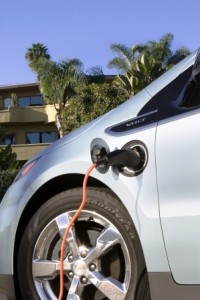The controversy about just how the Chevrolet Volt works may only get more cloudy after an interview with General Motors’ product development czar.
During a lengthy discussion, GM Vice Chairman Tom Stephens discussed the new patent the maker has received for the new power-flow system on the Chevrolet Volt. But while he acknowledged the maker’s decision to be silent until the patent was approved may have led to the current flap over precisely how the new Chevy battery car operates – Stephens only complicated questions about the technology.
And he again raises the question whether Volt should be described as a relatively conventional plug-in hybrid or, as GM prefers, an extended-range electric vehicle.
The system, under development for the last three years is designed to ensure that Volt’s wheels are driven only by electric power through a pair of what are called traction motors, said the executive.
The patent, which was issued last month, Stephens explained, is “specifically for the car’s unique power-flow system used in the Volt,” which, he insisted, “is what we’ve said it is all along – an extended-range electric vehicle.”
Stephens, however, admitted GM has kept quiet about the unique system, while the patent was pending, in order to protect its competitive advantage. “If I started to discuss this in 2007 but it won’t be available until 2010, why would I talk about” specifics, he said.
Offering to “show you the schematics,” Stephens appeared to counter comments made earlier this week by a senior Volt program executive who acknowledged that under “unique conditions” a small amount of direct, mechanical power from the car’s gasoline engine can be used to assist the electric motors.
According to GM’s Tony Posawatz, that could happen, for example, when a driver “tips in” the throttle while already cruising at freeway speeds.
(For that earlier story, Click Here.)
But according to Stephens, at no time is mechanical power used to drive Volt. Instead, all the power is supplied by the car’s electric motors, he insisted, rebutting assertions the Volt is actually a strong parallel hybrid that is given a mechanical boost at speeds over 70 miles per hour.
“You can run that (gasoline) engine all day and the car won’t move an inch because there is no clutch,” he said. “I know because I’m the guy who decided there should be no clutch,” he said.
Stephens also said that the Volt can go up to 100 miles per hour on battery power alone.
The key is the now-patented power-flow system, which was designed to eliminate the need for mechanical power, he said. “We came up with a unique power-flow system that keeps electricity
coming even when the battery is depleted. Any mechanical energy is converted specifically to electricity,” the Vice Chairman stressed.
“We’ve concentrated on making sure the Volt (buyers) have a great customer experience,” Stephens added.
Stephens also said that as the Chevrolet Volt begins its well-publicized roll-out more than 5,300 home and workplace charging stations are being installed in Michigan to help give Volt buyers options for charging their vehicles.
DTE Energy, the electric utility in Southeastern Michigan, has promised to install 2,500 240V home charging stations for plug-in vehicles, and Consumers Energy, another regional utlity, is matching that pledge. The utilities will cover up to $2,500 of the cost of the charging station and installation.
GM’s Voltec 240-volt home charging station is priced at just $490 but the typical installation process is expected to add an estimated $1,475.
GM is working with utilities and municipalities across the country – as is rival Nissan, which will soon launch the Leaf battery-electric vehicle – to ensure the availability of chargers both at home and on the road.
In Michigan, the city of Lansing’s Board of Water and Light will provide an additional 25 charging stations to by the end of 2011. GM also plans to have almost 350 charging stations in place for employees at its
facilities in Michigan, with more than 133 already installed.
In addition, more than 1,500 Chevrolet dealers across the U.S. plan to install charging stations for use by customers. This number includes nearly 650 dealers that will soon begin selling the Volt in initial retail
launch markets – which include Michigan and California — and approximately 900 others across the country that will begin offering Volt as its national roll-out continues.
“It’s just a start,” Stephens said.
Stephens said another 50 utility companies across the country have agreed to begin installing chargers in their service areas. Most of these will be placed in consumers’ garages, carports and driveways.

